German Shepherd Dog
Dogs
German Shepherd Dog
| German Shepherd Dog |
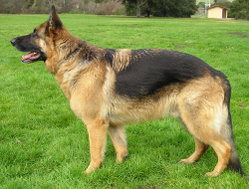
German Shepherd happy and panting after an
agility run
|
| Alternative names |
| Alsatian |
| Country of origin |
|
Germany |
| Common nicknames |
| |
| Classification and breed standards |
|
FCI: |
Group 1 Section 1 #166 |
|
|
AKC: |
Herding |
|
|
ANKC: |
Group 5 (Working Dogs) |
|
|
CKC: |
Group 7 - Herding Dogs |
|
|
KC (UK): |
Pastoral |
|
|
NZKC: |
Working |
|
|
UKC: |
Herding Dog Breeds |
|
| Not recognized by any major kennel club |
| This breed of dog is
extinct |
| Notes |
| |
The German Shepherd Dog (known also as the Alsatian or
Schäfer (hund) is an intelligent
breed of
dog. Because they are
eager to please, they are easily trained in
obedience and protection. German Shepherd Dogs are often used as
working
dogs in many capacities, including
search and rescue (SAR),
military,
police or
guard dogs.
They are also used as
assistance dogs /
service
dogs (such as
guide dogs),
though not as much as
Labrador Retrievers and
Golden Retrievers.
Appearance
The German Shepherd Dog is a large, strong, substantial-looking dog. The fur
is a double-coat and can be either short or long haired. It varies in color,
coming in many different shades, mostly cream (tan) and brown, but also solid
black or white. Dogs with coats that have tricolored hair (that is, black and
white and either brown or red) are called sable or agouti. Different kennel
clubs have different standards for the breed according to size, weight, coat
color and structure.
Common faults
Some GSDs have ears that never stand up completely; instead, the top 10 to 15
percent of the ear remains floppy. These are called "friendly-tipped" dogs. It
is a disqualifying fault in
show dogs.
A small percentage of GSDs have a tail that stands vertically, exposing their
anus. This is also a disqualifying fault in show dogs.
Breed lines
There are several types or lines of GSD and the behavior, abilities,
and appearance of each is quite different. The major lines are the international
working line, the international
show line,
and the North American show line.
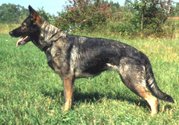 Black Sable (or gray) GSD, the original color and still common in working lines
Black Sable (or gray) GSD, the original color and still common in working lines
Dogs from
FCI-recognised international working lines are bred primarily for
traits involving their working ability rather than appearance, so their
appearance can be somewhat varied.
The FCI-recognised international show lines differ in that emphasis is
given more to the appearance of the dog when breeding, so they are very
consistent in type or appearance.
The North American show lines have also been bred primarily for their
looks, but have a markedly different appearance from the international dogs,
featuring a noticeably sloped back and sharp angulation of the hock joint. There
is a current debate over whether the American show lines still represent the
original German Shepherd Dog, or whether the line has become distinct enough
that it should be considered a separate breed. Critics of the American line
argue that the working ability of these dogs has been lost, and that the angled
back is detrimental to the health of the animal. Proponents of the line believe
that the altered bone structure of their dogs represents an improvement to the
herding ability of the animals.
In the erstwhile GDR,
the German Shepherds more closely adhered to the old prewar standard marked by
straighter back, longer and denser coat and darker color. These dogs are now
praised for breeding working dogs as they are less prone to
hip
dysplasia. Attempts to preserve this distinct line and raise it to the
status of an officially recognized breed ("East
German Shepherd Dog") are stalled.
Variant sizes and coats
Some groups or breeders have focused on variants or mutations of the breed
that are not recognized by most kennel clubs as acceptable
show GSDs
but that might eventually become breeds on their own.
- White coat
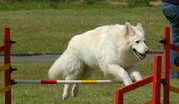 White German Shepherd Dog
White German Shepherd Dog
A white (or very light), but not
albino,
version of the German Shepherd has also always occurred, but was designated a
disqualifying fault in the AKC in the late 1960s; it is also considered a fault
by German breed standards. This fault, however, does not prevent the white
coated German Shepherd Dog from being registered in the AKC as a German Shepherd
Dog. White Shepherds hold champion titles in the UKC (United Kennel Club).
Now, some breeders selectively breed White Shepherds for their beautiful
snowy white coats and physical stature, striving for a Shepherd that closely
resembles the original dog; less angular than today's German Shepherd breed. See
the
WGSDCA or
American White Shepherd Association for more detail. However, the white
German Shepherd has been recognised by some organisations under the name
Berger Blanc Suisse (or
White Shepherd Dog).
- Long-haired coat
- The so-called "long-haired German Shepherd" is considered a "fault" in
the German Shepherd Dog breed according to American Kennel Club standards.
The long hair gene
is
recessive. Dogs with this coat look somewhat like the
Tervueren type of
Belgian Shepherd Dog. An example with pictures can be found
here. Popular myth holds that long-haired GSDs ("fuzzies") are more
affectionate, but there is little evidence for this.
- Giant shepherd
- Some organizations recognize a deliberately bred, larger variation of
the breed as the
Shiloh Shepherd Dog or other names.
Temperament
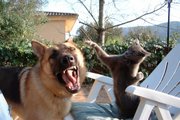 While attempting to play with a cat, a shepherd's teeth are displayed.
While attempting to play with a cat, a shepherd's teeth are displayed.
Well-bred GSDs have powerful jaws and strong teeth, can develop a strong
sense of loyalty and obedience, and can be trained to attack and release on
command. Poorly bred GSDs such as those from
puppy mills
can be fearful, overly aggressive, or both. The common misconception that GSDs
(like Pit Bulls)
are inherently violent is due most often to a combination of poor breeding (bad
nerves) and the owner's lack of control/training. Also to blame is the constant
media depiction of these dogs as guard or attack dogs, and dogs used by the
police, although they are more often used as dogs to search for things, as
opposed to dogs used for attack.
GSDs' sense of loyalty to, and emotional bond with, their owners is almost
impossible to overstate. Separation trauma is one reason they have been used
less in guide dog roles in recent years, since that program typically trains
dogs from puppyhood under one owner prior to final placement.
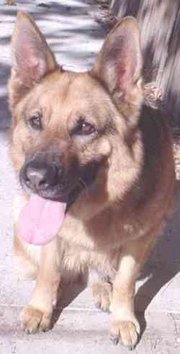 GSDs can make loyal and obedient pets.
GSDs can make loyal and obedient pets.
Temperament Differences Among Lines
The different types or lines of GSD display differences not only in
appearance but also in ability and temperament.
Dogs from working lines have very high energy, and have been bred to have a
natural drive for protection, tracking, and obedience. They are bred primarily
for consistent temperament, working drive, and intelligence. These dogs can be
used as pets, but will be unhappy if not exercised daily or trained to do a job
of some sort. These dogs are more commonly seen in rescues in North America due
to their high prey drive and owner's inability to control or train them.
German and Eastern European lines tend to be stockier, with shorter snouts
and more muscular chests, and typify the working lines.
North American lines have a tendency towards a longer croup, longer back,
higher wither and more stable temperament ideal for companionship. They do not
require something to do constantly to keep them from becoming bored and without
an outlet, destructive.
These dogs can make excellent pets, provided that an irresponsible breeder
has not sacrificed consistent temperament or health in the quest for popular
standards for good looks.
Health
As is common in many large breeds, German Shepherds are prone to elbow and
hip
dysplasia. Other health problems sometimes occurring in the breed are
von Willebrand's disease and skin
allergies.
German Shepherds are also prone to
bloat. They have
an
average life span of ten to twelve years.
History
The breed was originated by Captain Max von Stephanitz in the late 1800s and
early 1900s. His goal was to breed an all-purpose
working
dog. The first registered GSD was Horand v. Grafrath
[1]. Von Stephanitz admired the
landrace
herding
dogs of his native Germany, and believed they had the potential to be
all-purpose working dogs. Additionally, he was aware of the declining need for
herding dogs and believed that the working abilities of the breed would decline
unless it was put to other uses. Von Stephanitz created the Verein für
Deutsche Schäferhunde
[2], or SV as the official governing body for the breed. The SV then created
the
schutzhund trial as a breed test for the German Shepherd Dog, and prohibited
the breeding of any dog which could not pass the trial. The schutzhund trial,
along with the SV's conviction that "German Shepherd breeding is working dog
breeding, or it is not German Shepherd breeding" led to a rapid development of
the breed's abilities. After WWI, British and American soldiers, impressed by
the abilities of the dog, brought home examples to breed. The breed instantly
become popular, both as a family pet and as a working dog. To this day, the
German Shepherd Dog is considered one of, if not the most intelligent and
versatile breeds in existence.
 GSDs commonly display high intelligence, which makes them ideal candidates for
various working class positions.
GSDs commonly display high intelligence, which makes them ideal candidates for
various working class positions.
Working German Shepherd Dogs
German Shepherds often compete and excel in
obedience trials and
Schutzhund
competitions. German Shepherds are also often trained as
police dogs,
due to their trainability, size and work drive.
Shepherding
The original purpose for the German Shepherd Dog, was (not surprisingly) to
herd sheep, cattle or any other animal that may require the assistance of a
shepherd. Even given the name "shepherd" some people are surprised to hear that
these dogs were bred for herding, as the GSD is more often found working as a
guard dog, police dog or companion pet than in the field working sheep.
The German Shepherd Dog does not have the "eye" as border collies or other
similar breeds. They are trained to follow their instinct, which for the GSD is
to "work the furrow", meaning that they will patrol a boundary all day and
restrict the animals being herded from entering or leaving the designated area.
It is this instinct that has made the breed superb guarding dogs, protecting
their flock (or family) from harm.
A German Shepherd Dog's instincts to herd might manifest themselves by the
dog closely watching or even nipping at members of its family as they go for
walks. The dog might attempt to lead people to what it perceives is the correct
location, even going so far as to gently take a hand in his teeth to lead the
person.
Miscellaneous
Breed names
The proper English name for the breed is German Shepherd Dog (a
literal translation from the German "Deutscher Schäferhund") but they are
usually informally referred to as GSDs or simply German Shepherds.
Alsatian is also commonly used in the
United Kingdom and countries of the
Commonwealth of Nations (the reason for the alternative name is historical:
during World Wars I and II, Germany was out of favour in the UK and many German
names were translated or anglicised. See more below under Breed Name History).
In addition, the sobriquet police dog is used in many countries where the
GSD is the predominant or exclusive breed used in the canine police force.
Breed Name History
The anti German sentiment which followed the First World War caused the
British to re-name the breed as the Alsatian Wolf Dog. The breed began to spread
world-wide after World War I, when a few dogs were taken to England. At that
time, however, it was known as "Alsatian Shepherd", as it was inappropriate that
the breed's name could be a reminder of the war against Germany. Only in 1930
did the British Kennel Club authorise the breed to be known again as German
Shepherd.
Despite fads, poor breeding practices, malign-ment of character as "attack"
dogs, and discrimination against anything German during the years of and
following World War I, the breed has thrived. During the German phobia, English
owners refused to give up the breed they had come to admire. They did compromise
and change the name to Alsatian, which prevailed for nearly 40 years after all
hostilities ended.
The term "Alsatian" is an incorrect name for the breed and was coined within
the British Kennel Club as part of an attempt to divorce the breed from its
German origins, due to historical enmity.
Famous Shepherds
- Blondi,
pet of
Adolf Hitler
- Bullet, the Wonder Dog - Roy Roger's dog
- Charlie, from
All Dogs Go to Heaven
- Clipper, pet of
John F. Kennedy
- Major, pet of FDR
-
Rex (a.k.a Reginald von Ravenhorst) from
Kommissar Rex
- Rin Tin Tin
- Strongheart
-
The Littlest Hobo
-
Ace the Bat-Hound
External links
Home | Up | Galgo Espańol | German Shepherd Dog | German Shorthaired Pointer | German Spitz | German Wirehaired Pointer | Giant Schnauzer | Glen of Imaal Terrier | Golden Retriever | Goldendoodle | Gordon Setter | Grand Basset Griffon Vendeen | Grand Bleu de Gascogne | Grand Griffon Vendéen | Great Dane | Greater Swiss Mountain Dog | Greenland_Dog | Greyhound | Griffon Bruxellois
Dogs, made by MultiMedia | Free content and software
This guide is licensed under the GNU
Free Documentation License. It uses material from the Wikipedia.
|




